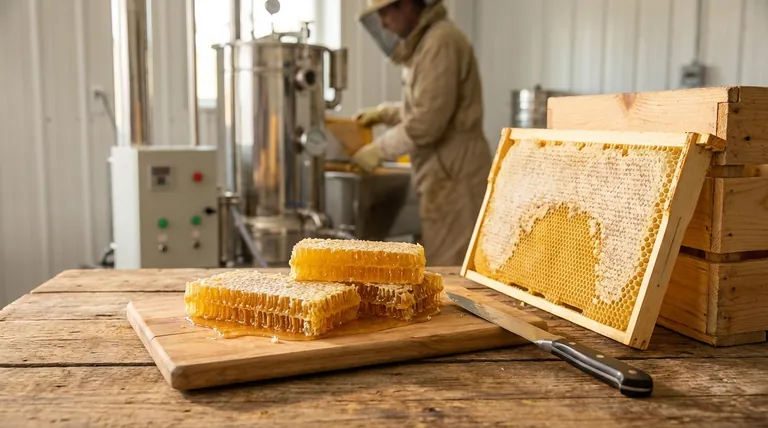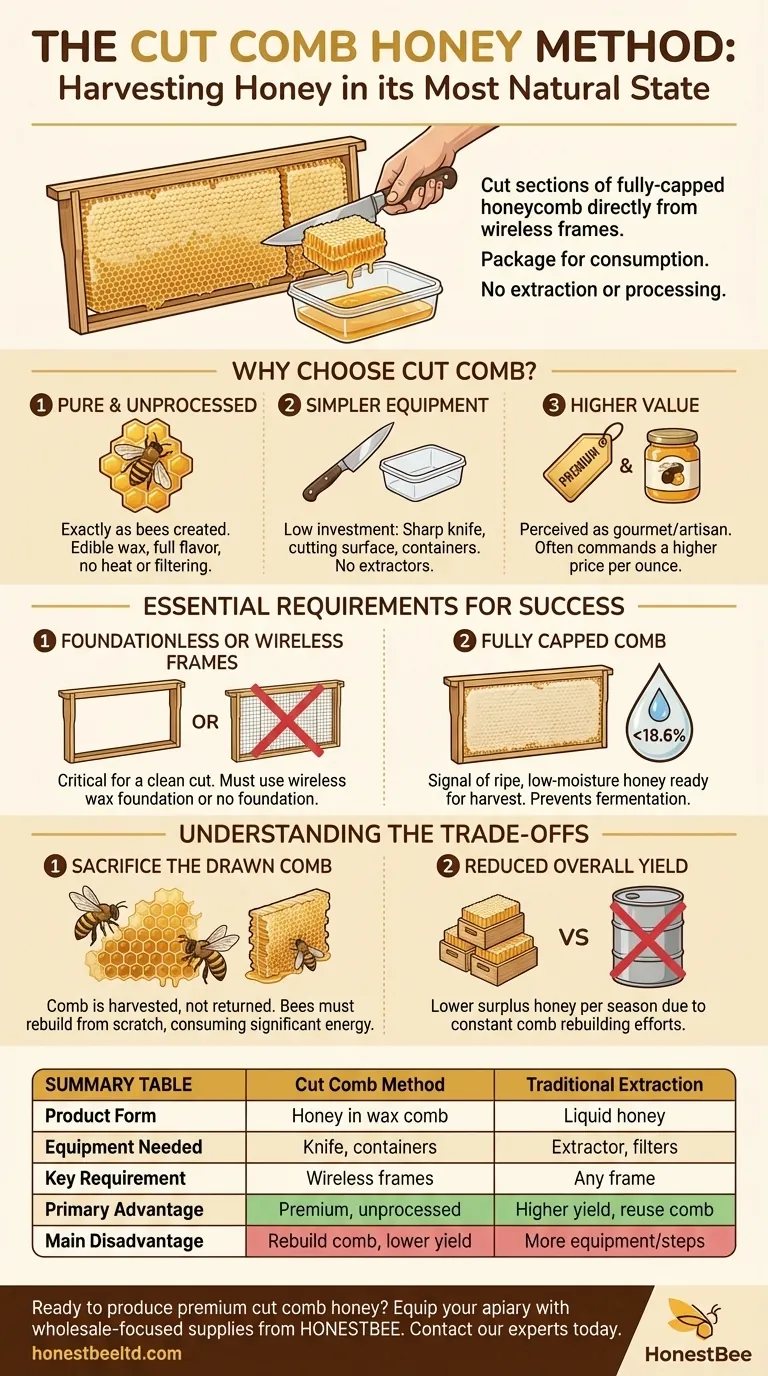In beekeeping, the cut comb honey method is a technique for harvesting honey in its most natural state. It involves cutting sections of fully-capped honeycomb directly from the frame, letting them drain, and then packaging the wax-and-honey sections for consumption without any extraction or processing.
The success of cut comb honey is determined before the harvest even begins. This method works exclusively with frames that have no internal wires, allowing a knife to pass through cleanly and produce unadulterated, perfect sections of comb.

Why Choose the Cut Comb Method?
While honey extraction is common, producing cut comb has distinct advantages that appeal to many beekeepers, particularly those focused on a premium, natural product.
A Pure and Unprocessed Product
Cut comb is honey presented exactly as the bees created and stored it. The wax is fully edible and the honey is not filtered, heated, or processed, retaining its full spectrum of delicate flavors and aromas.
Simpler Equipment Requirements
Traditional harvesting requires a significant investment in equipment like an uncapping knife, a centrifugal extractor, filters, and bottling tanks. For cut comb, all you need is a sharp knife, a cutting surface, and appropriate containers.
Higher Perceived and Market Value
Because of its beauty and raw nature, cut comb honey is often seen as a gourmet or artisan product. It frequently commands a higher price per ounce than extracted liquid honey.
Essential Requirements for Success
You cannot decide to produce cut comb from just any hive. The entire process hinges on having the right foundation and conditions in the super.
Foundationless or Wireless Frames
This is the most critical requirement. Standard frames often have vertical wires embedded in the wax foundation to provide strength and support. You cannot cut through these wires. Therefore, you must use frames with wireless wax foundation or no foundation at all (foundationless beekeeping).
Fully Capped Comb
A frame is ready for harvest only when the bees have capped nearly all the cells with a fresh layer of white wax. This "capping" is your signal that the bees have fanned the nectar down to the proper moisture content (below 18.6%), ensuring the honey is "ripe" and will not ferment.
Understanding the Trade-offs
While appealing, the cut comb method is not without its significant drawbacks, primarily centered on colony resources and overall efficiency.
You Sacrifice the Drawn Comb
The single biggest trade-off is the loss of the wax comb. It takes bees an immense amount of energy to produce wax and draw it into a perfect honeycomb structure. With traditional extraction, that comb is returned to the hive for reuse, saving the bees work. With cut comb, that energy investment is harvested along with the honey, and the bees must start over.
It Reduces Overall Honey Yield
Because the bees must constantly rebuild the comb from scratch, a colony dedicated to cut comb production will produce significantly less surplus honey over a season compared to a colony where drawn comb is reused.
It Is Not Universally Applicable
This method is a non-starter if your apiary is already established with standard wired-foundation frames. It requires a deliberate choice in equipment from the very beginning.
Making the Right Choice for Your Apiary
Deciding between cut comb and liquid extraction depends entirely on your goals as a beekeeper.
- If your primary focus is producing a premium, artisanal product: The cut comb method is an excellent choice that beautifully showcases the natural quality of your honey.
- If your primary focus is maximizing honey yield and colony efficiency: Traditional extraction is superior because it preserves the bees' valuable drawn comb for immediate reuse.
- If your primary focus is practicing foundationless beekeeping: Cut comb harvesting is the most natural and direct method to use with your frames.
Ultimately, choosing the cut comb method is a decision to prioritize the raw, unprocessed form of honey over maximum production volume.
Summary Table:
| Aspect | Cut Comb Method | Traditional Extraction |
|---|---|---|
| Product Form | Honey in the wax comb | Liquid honey |
| Equipment Needed | Sharp knife, containers | Extractor, uncapping knife, filters |
| Key Requirement | Wireless or foundationless frames | Any frame type |
| Primary Advantage | Premium, unprocessed product | Higher honey yield, comb reuse |
| Main Disadvantage | Bees must rebuild comb, lower yield | More equipment and processing steps |
Ready to produce premium cut comb honey? Equip your apiary with the right supplies from the start. HONESTBEE supplies commercial apiaries and beekeeping equipment distributors with the wholesale-focused equipment needed for success, including wireless foundations and frames. Contact our experts today to discuss your beekeeping needs and how we can support your operation.
Visual Guide

Related Products
- Honey Concentrating Vacuum Heating Thickening Machine Dehumidifier for Honey
- Professional Thermostatic Conical Honey Melter
- High Quality Honey Dehumidifier Dryer Thickening Machine for Beekeeping
- Plastic Hand Crank 2 Frame Honey Extractor Low Price
- Professional Extra-Wide Uncapping Fork with Bent Tines for Beekeeping
People Also Ask
- What is the effect of excess moisture on honey's nutrients? Preserve Quality and Prevent Spoilage
- What are the benefits of a honey concentrator? Elevate Your Honey Quality and Market Value
- What safety precautions should be taken when operating the honey vacuum thickener? Protect Your Apiary Investment
- What steps should be followed when starting and stopping the vacuum pump in the honey vacuum thickener? Protect Your Honey & Equipment
- What is required for the cooling system when using circulating water in the honey vacuum thickener? Essential Components for Efficient Processing



















